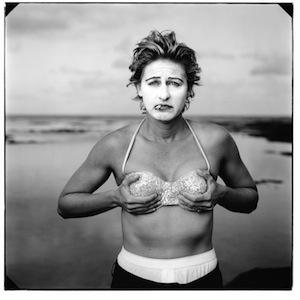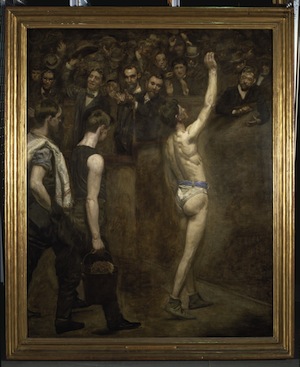Clearly Andy Warhol is not the least bit camouflaged in his series of "Camouflage Self-Portraits." The fatigue-like camouflage over his pale, opalescent face obscures nothing. Warhol is hiding in plain sight. Staring at the silkscreen, all I could think was: "Don't Ask, Don't Tell."
I was at the National Portrait Gallery's show "Hide/Seek: Difference and Desire in American Portraiture." The Portrait Gallery, a part of Washington DC's incomparable Smithsonian Institution, is the first preeminent museum to dedicate an entire exhibition to gay and lesbian portraiture. Although we should credit the UC Berkeley Art Museum, which led the way in 1995 with a smaller, regional exhibit entitled "In A Different Light".
 The Portrait Gallery's exhibit takes us from the 1890s, with a Thomas Eakins photo of Walt Whitman and commentary on his "Leaves of Grass," to the twenty-first century, with an Annie Leibovitz portrait of Ellen DeGeneres -- in which she looks astonishingly like Sean Penn with a painted white face -- mocking Playboy pinups. Early in the show, there is another remarkable Thomas Eakins painting. It is a boxing picture, but unlike his best-known work, which concentrates on muscled power, its subject is a featherweight boxer, slim and seen from the rear. The crowd of swells, virtually all men, is focused on this nearly naked young man in an admiring, even lascivious way; this is the sort of leering that has mostly been seen in paintings of men looking at naked women. It is not a "gay" painting, but it certainly says something about same sex attraction.
The Portrait Gallery's exhibit takes us from the 1890s, with a Thomas Eakins photo of Walt Whitman and commentary on his "Leaves of Grass," to the twenty-first century, with an Annie Leibovitz portrait of Ellen DeGeneres -- in which she looks astonishingly like Sean Penn with a painted white face -- mocking Playboy pinups. Early in the show, there is another remarkable Thomas Eakins painting. It is a boxing picture, but unlike his best-known work, which concentrates on muscled power, its subject is a featherweight boxer, slim and seen from the rear. The crowd of swells, virtually all men, is focused on this nearly naked young man in an admiring, even lascivious way; this is the sort of leering that has mostly been seen in paintings of men looking at naked women. It is not a "gay" painting, but it certainly says something about same sex attraction.
The show is organized chronologically and from this beginning to the achingly touching paintings by Robert Rauschenberg and Jasper Johns marking the end of their relationship with each other, there is an arc from the totally hidden toward the mostly open. There are over 100 works, some accompanied by music and poetry. Being a gay artist is not a prerequisite for being included in the exhibit, though the themes are all about being and/or feeling attracted to the same sex. Many of the works are familiar; all are major works of art. There are no avant garde pieces by unknown artists.
 For fear of losing federal grants, DC's Corcoran Gallery of Art canceled its Robert Mapplethorpe exhibition in 1989, which included depictions of homosexuality and male nudity. Times have changed dramatically since then. The co-curators -- Jonathan D. Katz, former executive curator of the Larry Kramer Initiative for Lesbian and Gay Studies at Yale and current director of the visual studies doctoral program at SUNY-Buffalo, and David C. Ward historian at the National Portrait Gallery - do not consider this show an act of courage, but rather a necessary and important show, particularly at this moment in history. They are exceptionally proud that it is at the Portrait Gallery -- the museum of biography.
For fear of losing federal grants, DC's Corcoran Gallery of Art canceled its Robert Mapplethorpe exhibition in 1989, which included depictions of homosexuality and male nudity. Times have changed dramatically since then. The co-curators -- Jonathan D. Katz, former executive curator of the Larry Kramer Initiative for Lesbian and Gay Studies at Yale and current director of the visual studies doctoral program at SUNY-Buffalo, and David C. Ward historian at the National Portrait Gallery - do not consider this show an act of courage, but rather a necessary and important show, particularly at this moment in history. They are exceptionally proud that it is at the Portrait Gallery -- the museum of biography.
The extremely provocative show leaves you astonished at your new understanding of familiar, famous works. It's like exploring well-known landscapes and finding hidden treasures. There are codes and secrets to be discovered in virtually every work. For example, in the seldom seen Romaine Brooks' painting of critic, photographer and novelist Carl Van Vechten, there are barely visible faces of African-American boys in the dark background behind an icy-white, rather creepy Van Vechten. The respectable, married Van Vechtin was known for cruising Harlem for young men during a time when many whites went uptown to 125th Street to escape what they felt were their uninspired, conventional lives.
The written narrative is excellent and the audio can be accessed free of charge on smart phones. The Portrait Gallery, like all of the Smithsonian, has no admission fee, thanks to federal funding and generous private benefactors. The show will be in DC until the day before Valentine's Day 2011. It's worth the trip just to see it.
In today's Washington, we find ourselves looking to the Portrait Gallery for leadership, not our elected officials.